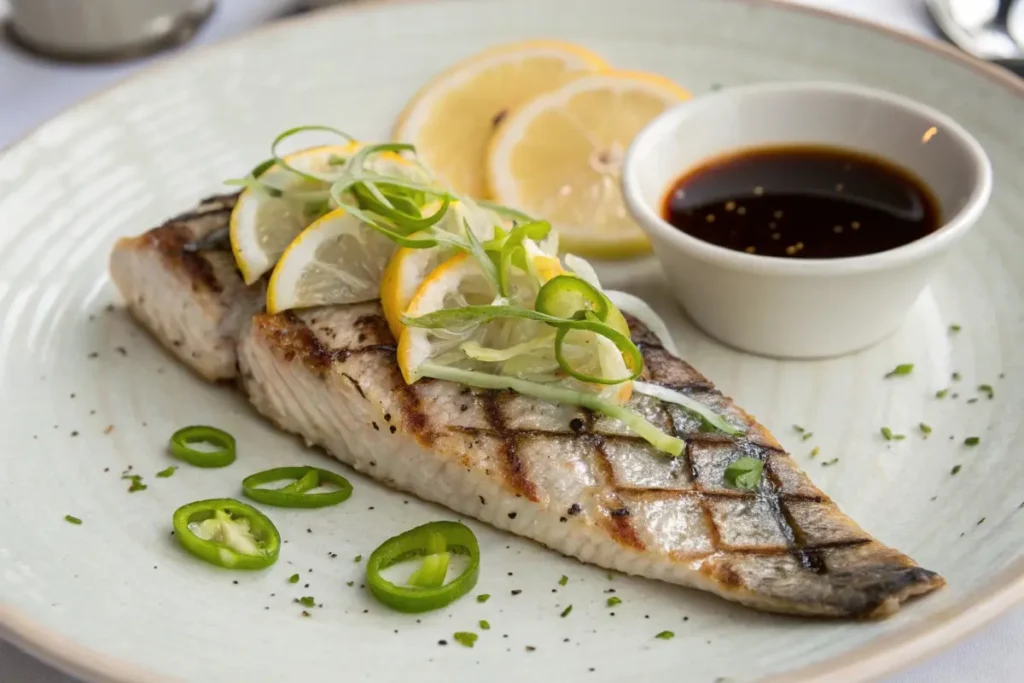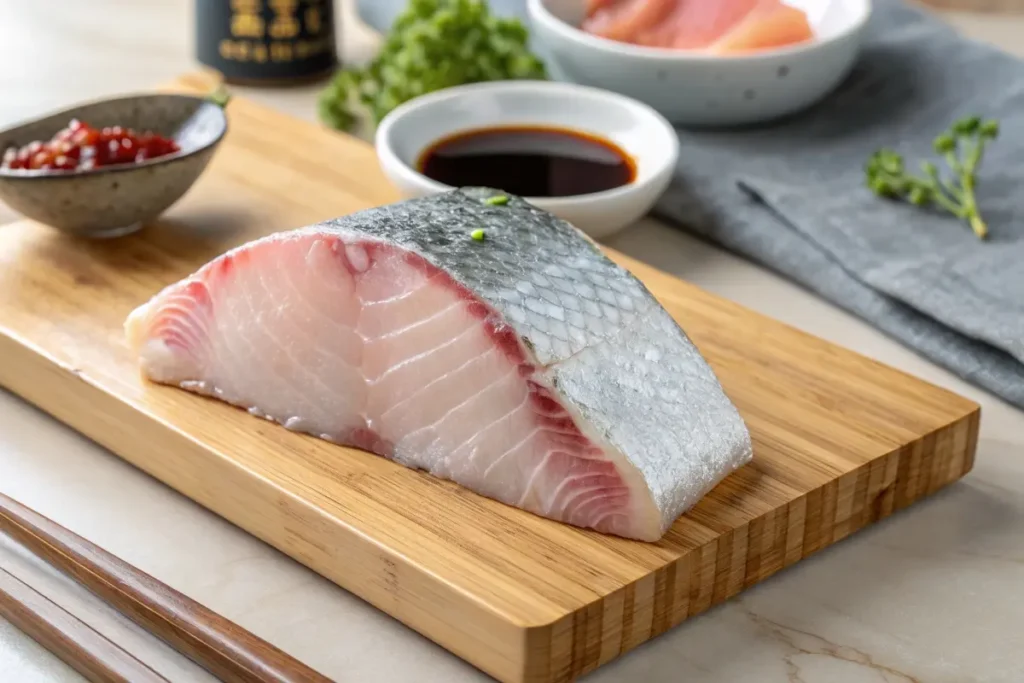
Few culinary delights captivate the palate quite like hamachi collar, a succulent cut from the yellowtail fish that offers an unparalleled blend of tender meat, rich flavor, and melt-in-your-mouth texture. Within the first bite, it’s easy to see why hamachi collar—also known as hamachi kama—is frequently regarded as one of the prized specialties in Japanese seafood cuisine. While many people enjoy sushi or sashimi made from leaner sections of the yellowtail, there’s something uniquely rewarding about digging into the fattier, more flavorful collar portion right behind the fish’s head.
Adding hamachi collar to your repertoire can elevate everyday dinners into memorable feasts. When perfectly grilled or broiled, its crispy exterior and juicy interior bring forth a signature sweetness, complemented by savory notes of the ocean. Whether you’re a seasoned cook yearning for new Japanese specialties or a beginner who loves exploring global flavors, delving into hamachi collar is well worth the effort. You’ll soon find it’s not only easy to cook but also highly adaptable to various techniques—like direct grilling, oven-broiling, or even air frying. Plus, it pairs wonderfully with a range of sauces, from light ponzu to more robust teriyaki or chili-based condiments.
Discover more creative Japanese dishes here to round out your seafood-inspired menu. In this guide, we’ll explore everything you need to know about hamachi collar—from its basics and historical roots to cooking techniques, nutritional insights, and frequently asked questions.
Print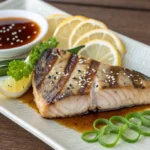
Hamachi Collar: A Gourmet Guide to Yellowtail’s Hidden Gem
- Total Time: 15 minutes
- Yield: 2 servings 1x
Description
Hamachi Collar – the succulent cut from behind the gills of the yellowtail, grilled or broiled with salt and sesame oil or mirin until crisp on the outside and tender inside; served with lemon, ponzu sauce, and sliced scallions for a balanced umami finish.
Ingredients
2 yellowtail collars (hamachi kama)
High‑quality sea salt
1–2 tsp sesame oil or mirin (optional)
Lemon wedges, for serving
Ponzu sauce, for dipping
Chopped scallions or green onions
Instructions
1. Rinse collars and pat dry.
2. Season both sides with sea salt; optionally brush lightly with sesame oil or mirin.
3. Preheat broiler or grill to medium‑high (rack approx. 15 cm from heat).
4. Place collars skin‑side down on foil or grill; broil for 8–10 minutes until blistered.
5. Flip and cook additional 2–3 minutes until skin is crisp.
6. Serve immediately with lemon wedges, ponzu sauce, and scallions.
Notes
Let salted collars rest 15–20 minutes before cooking to enhance flavor and remove excess moisture :contentReference[oaicite:6]{index=6}.
Air fryer or pan‑fry methods are also effective: air fry at 400°F for 8–10 min, flipping halfway :contentReference[oaicite:7]{index=7}.
Hamachi collar is naturally rich in omega‑3 and yields tender, juicy meat difficult to overcook :contentReference[oaicite:8]{index=8}.
- Prep Time: 5
- Cook Time: 10
- Category: Main Dish
- Method: Broiling or Grilling
- Cuisine: Japanese
Nutrition
- Serving Size: 1 collar (~150 g)
- Calories: 270
- Sugar: 0g
- Sodium: 400mg
- Fat: 18g
- Saturated Fat: 3g
- Unsaturated Fat: 12g
- Trans Fat: 0g
- Carbohydrates: 0g
- Fiber: 0g
- Protein: 24g
- Cholesterol: 90mg
Keywords: hamachi collar recipe, yellowtail collar, hamachi kama, grilled fish
Table of Contents
The Basics of Hamachi Collar
What Is Hamachi Collar?
Hamachi collar—also called kama—is the portion of the yellowtail fish located near the gill plates and pectoral fins. It’s the wedge-shaped area where the fish transitions from its head to its body, housing some of the most tender, fatty, and flavorful meat. Rich in natural oils, this segment offers a luxurious taste and texture that many seafood aficionados rank among the finest in Japanese cuisine.
While other parts of the fish might be leaner or better suited for sashimi, the collar benefits from the fish’s daily movements and fat distribution. The result is a juicy cut that remains moist even when subjected to high-heat cooking methods like grilling or broiling. Its high fat content not only ensures flavor but also preserves tenderness and keeps the meat flaky.
The Appeal of Hamachi Collar
- Unmatched Flavor
The collar’s concentrated fatty tissue delivers a distinctive sweetness and umami punch. It typically tastes richer than standard fillets or loins, delighting those who crave melt-in-your-mouth seafood experiences. - Versatile Cooking Methods
Whether you opt to grill hamachi kama, sear it in a pan, or slide it into an oven for a slow roast, the collar’s high fat content makes it forgiving and adaptable. Even if you stray slightly from recommended cooking times, the moistness remains intact. - Availability and Specialty
Hamachi collar isn’t always available at the average fish market. Considered a delicacy, it sometimes requires special ordering or seeking out a Japanese market or a fishmonger who appreciates nose-to-tail usage of fish. Because of its relatively low supply, it often sells quickly once it reaches store counters.
Distinguishing Hamachi from Other Yellowtail Species
In Japan, the term “hamachi” usually indicates a yellowtail fish at a particular growth stage—between one and two years old. As it matures, it might be referred to as buri, while smaller forms are sometimes called wakashi or inada. This progression influences the fish’s flavor, fat distribution, and size.
- Young Yellowtail (Inada/Wakashi): Light taste, less fat.
- Hamachi: Slightly older, with a higher fat percentage and richer flavor.
- Buri: The largest, often the fattiest and most mature yellowtail, sometimes surpassing hamachi in richness.
Selecting the Best Collar
If you’re lucky enough to spot hamachi collar at a seafood counter or Japanese grocery, keep these tips in mind:
- Freshness: The flesh should appear moist, with no fishy or off odor.
- Color: Look for a faint pink or beige hue, with minimal browning.
- Size: Collars can vary widely. Larger ones typically yield more meat, but smaller ones can be equally delicious—especially if you prefer a milder flavor.
Ultimately, hamachi collar presents a unique intersection of flavor, texture, and cultural heritage. Understanding its place in the fish’s anatomy highlights why this portion stands out among standard fillets. Next, we’ll explore how to bring out the best in this prized cut by delving deeper into cooking techniques and flavor pairings.
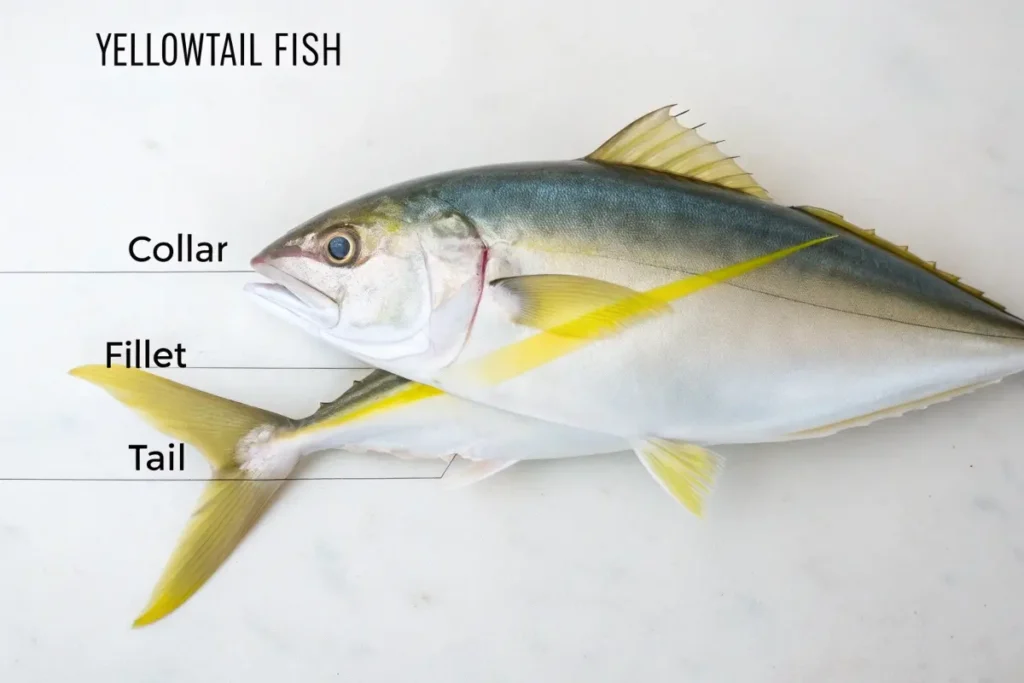
For another example of prized Japanese seafood, see our Japanese Scallop Recipe to discover more ways to savor ocean-fresh ingredients.
Culinary Techniques for Cooking Hamachi Collar
Grilling Hamachi Kama
Perhaps the most classic method, grilled hamachi kama is revered for its slightly charred skin that contrasts perfectly with the succulent meat beneath. The direct flame intensifies the collar’s natural sweetness while creating crispy edges.
- Preparation
- Pat the collar dry to remove moisture.
- Lightly salt the surface and let it rest for 15–20 minutes to enhance flavor and draw out any excess water.
- Optionally, marinate with a splash of soy sauce, mirin, or sake for a delicate infusion of Japanese flavors.
- Cooking Process
- Preheat your grill to medium-high heat (around 375–400°F).
- Place the collar skin side down first. Cook for 4–5 minutes, then flip carefully.
- Continue grilling until the flesh turns opaque and flakes easily, about 3–4 minutes on the second side.
- Serving
- Spritz with lemon or yuzu juice for a citrusy spark.
- Accompany with daikon oroshi (grated daikon radish) and a sprinkle of chopped scallions.
Oven-Broiling and Baking
If you don’t have access to an outdoor grill or you prefer simpler indoor methods, hamachi collar adapts beautifully to oven broiling or baking. Broiling approximates the direct heat of a grill, while baking yields gentler, more uniform cooking.
- Broiling: Place the collars on a foil-lined pan. Position them about 3–4 inches below your oven’s broiler. Watch carefully to prevent scorching. A few minutes on each side typically suffices.
- Baking: Bake at 400–425°F for 10–15 minutes, depending on thickness. For additional browning, switch to broil mode for the last minute or two.
Air Fryer Approach
Increasingly popular, hamachi kama air fryer methods deliver near-effortless results with minimal cleanup. The circulating hot air crisps the exterior without excessive oil:
- Preheating: Warm the air fryer to approximately 375–380°F.
- Seasoning: A light rub of salt, pepper, and a drizzle of oil ensures a tasty crust.
- Cooking: Depending on size, cook for 10–12 minutes, flipping halfway. Keep an eye out to avoid over-drying.
Flavor Enhancements
Traditional Japanese Seasonings
- Shioyaki-Style: Simple salt rub, letting the fish’s own flavors shine.
- Teriyaki Glaze: A blend of soy sauce, sugar, mirin, and sake forms a sweet-savory coating that caramelizes beautifully.
Sauce Pairings
- Ponzu: A citrusy soy-based sauce that cuts through the richness.
- Ginger Soy Reduction: Warm ginger meets salty soy for a cozy, aromatic finish.
- Spicy Miso: A lightly sweet, fermented backdrop with a hint of heat.
Recommended Accompaniments
Pair your hamachi collar with steamed white rice, miso soup, or a crisp salad. This well-rounded approach balances the fish’s richness, turning your meal into a harmonious Japanese dining experience.
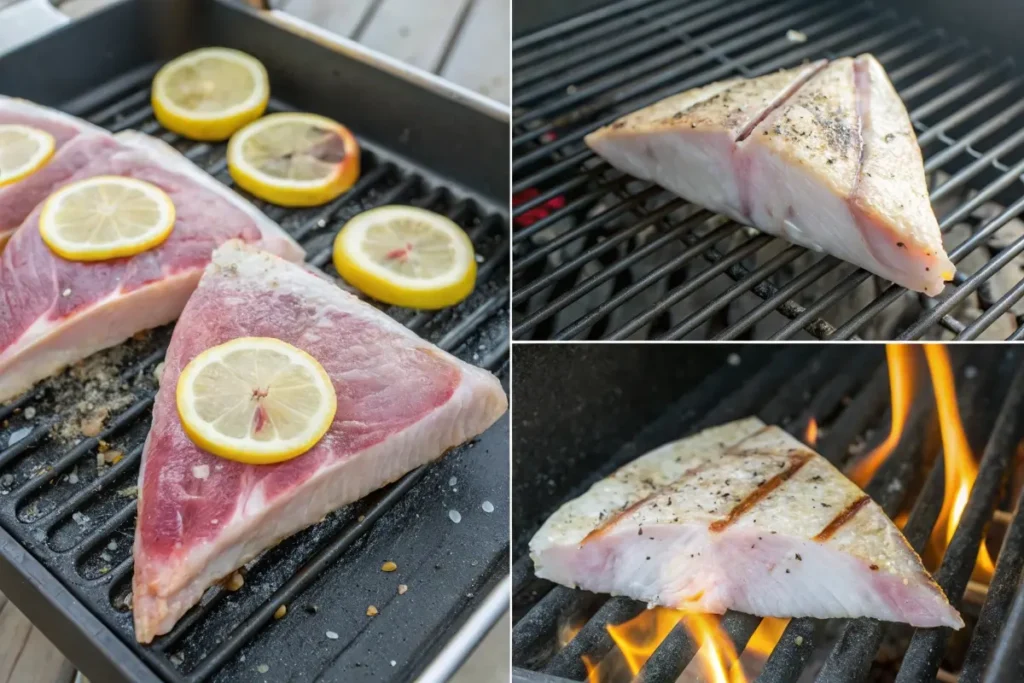
For a sauce that can complement grilled fish, explore our Japanese BBQ Sauce Chicken Recipe—the marinade or glaze can be adapted for hamachi collars too.
Flavor Profile, Nutrition, and Perfect Pairings
Flavor Profile
Hamachi collar is lauded for its delicate yet distinctly rich flavor. At first bite, you may notice:
- Sweetness: The natural fish oils impart a faint sweetness that’s not overpowering.
- Savory Depth: A mild brininess resonates, hinting at the fish’s oceanic origins but never turning “fishy.”
- Buttery Texture: Thanks to the higher fat content, the flesh has a lush, silky consistency, especially near the joints.
For those pondering what does a hamachi collar taste like, imagine a more succulent, indulgent version of typical white fish or salmon.
Nutritional Benefits
Despite its luxurious taste, hamachi collar offers valuable nutrients:
- Protein: Yellowtail is a great source of high-quality protein for muscle maintenance.
- Omega-3 Fatty Acids: The collar portion contains especially high concentrations of healthy fats, which may support heart health and reduce inflammation.
- Vitamins and Minerals: Rich in B-vitamins (notably B12), along with selenium and potassium, essential for cellular function and electrolyte balance.
Of course, moderation matters. The collar’s high fat content can be calorie-dense. Still, these are generally beneficial unsaturated fats that provide a flavorful, satisfying meal.
Ideal Side Dishes
To complement the succulent fish, consider these pairings:
- Steamed Vegetables: Broccoli, bok choy, or asparagus lightly seasoned with salt and sesame oil.
- Miso Soup: Adds a comforting, umami-laced warmth to your meal.
- Pickled Sides: Tsukemono (Japanese pickles) like pickled cucumber or ginger balance out the fish’s richness.
Beverage Recommendations
- Sake: A crisp, dry sake (like Junmai or Ginjo) elevates the fish’s sweetness while cutting through the fattiness.
- Green Tea: A hot or iced green tea can cleanse the palate between bites, making each taste of hamachi collar feel fresh.
- Light Beer: If you prefer beer, a lighter lager or pilsner pairs well, especially if you’re enjoying a grilled hamachi kama in a casual setting.
Serving Style and Presentation
A common practice in Japanese restaurants is to serve hamachi collar on a simple white plate, often garnished with grated daikon, lemon wedges, and perhaps a small bowl of soy sauce or ponzu. The aesthetic approach typically highlights the fish itself, allowing its golden-brown crisp edges to showcase a visual treat.
Overall, hamachi collar stands as a balanced indulgence. Its pronounced flavor and tender mouthfeel work best with straightforward accompaniments, accentuating the fish’s natural richness. With the right sides, sauces, or beverages, you’ll find hamachi collar can evolve from a specialty cut into a staple in your dinner rotation.
If you crave more seafood ideas, try exploring our Japanese Shrimp Recipes for additional inspirations to complete your seafood feast.
Comparing Hamachi Collar, Yellowtail, and Other Fish Cuts
The Yellowtail Confusion
Hamachi refers to a growth stage of the yellowtail (Seriola quinqueradiata), often distinct from older fish known as buri. Many diners wonder, What kind of meat is hamachi? In essence, it’s a mid-aged fish with moderate fat content, prized for sushi and sashimi. Hamachi collar denotes the collar from that same fish.
Yet, the word “yellowtail” can also apply to other species in the Seriola genus, such as the greater amberjack or the California yellowtail. While these fishes have similarities, the Japanese hamachi specifically refers to the farmed or wild species that reach markets as sashimi-grade fish.
Hamachi Collar vs. Standard Fillets
- Fat Content: Collars hold higher fat levels compared to fillets. This extra fat equates to buttery flavor and moist texture.
- Texture Variations: Fillets can be more uniform, while the collar includes pockets of collagen and cartilage. Some individuals savor these gelatinous bits for their succulent mouthfeel.
- Cooking Approach: Fillets might do well in delicate applications like steaming or sushi, but collars thrive under direct heat (grill, broil) or robust cooking methods that highlight their rich oils.
The Allure of ‘Toro’-Like Qualities
In sushi bars, “toro” is the term reserved for the fattier belly sections of tuna. While hamachi collar isn’t technically toro, it shares a similarly lush mouthfeel thanks to its abundant oils. Some even joke that hamachi collar is the “toro of yellowtail,” as it offers an opulent taste akin to premium tuna belly—but at a more approachable price.
Alternative Fish Collars to Explore
- Salmon Collar: Less common, but similarly fatty and succulent around the pectoral fins.
- Tuna Collar: Harder to find, but extremely rich—best approached with caution due to high cost and intense flavors.
- Snapper Collar: Often recognized for a flakier texture. Not as high in fat, but still worthwhile if you enjoy the collar’s unique structure.
In short, hamachi collar stands at an intersection of moderate cost, availability, and luscious taste. Its distinct position on the fish ensures a superior, melt-in-your-mouth experience, unlike leaner cuts. Understanding these differences can guide you in selecting the ideal fish cut, whether you aim to replicate your favorite sushi bar’s delicacy or experiment with lesser-known collar options.
If you’re exploring distinctive cuts of fish, you might also appreciate our Easy Japanese Tuna Salad Recipe for a quick lunchtime upgrade.
History and Examples
History/Context of Hamachi Collar
While the precise origin of savoring hamachi collar remains lost to time, the practice likely emerged from Japan’s broader philosophy of mottainai (waste nothing). Historically, fishermen and cooks sought to use every part of the fish, discovering that the collar area delivered flavors rivaling prime fillets.
Feudal Japan and Fishing Villages
During the Edo period (1603–1867), fish was a staple protein, especially in coastal regions. Skilled fishermen recognized certain sections—like the collar—were especially tender. Over generations, local recipes evolved to highlight these “hidden” cuts, often grilling them over charcoal for a smoky aroma.
Rise of Sushi Culture
As sushi culture blossomed in the 19th century, numerous fish cuts gained popularity for raw consumption. However, the collar, with its bones and heavier fat layers, wasn’t as convenient for sashimi or nigiri. Instead, it became prized by grill masters and home cooks who discovered that high-heat cooking melted the collagen and oils into mouthwatering goodness.
Modern Restaurant Menus
In the 20th century, Japanese restaurants began exporting their cuisine worldwide, leading to the globalization of sushi, sashimi, and other delicacies. Initially overshadowed by iconic items like salmon or tuna belly, hamachi collar eventually surfaced as a must-try menu item for connoisseurs. Over time, some sushi bars started presenting grilled hamachi kama as a side or appetizer, bridging the gap between raw seafood offerings and cooked dishes.
Contemporary Trends
Today, hamachi collar enjoys a dual identity: a cherished local staple in Japanese households and a gourmet highlight in upscale restaurants globally. Innovative chefs incorporate it into fusion dishes, sometimes brushing it with miso glazes or presenting it in air-fried forms. Despite these modern twists, the essence remains unchanged—an emphasis on the collar’s naturally rich flavors and tender flesh.
Delve further into Japanese culinary evolution by checking out our Traditional Japanese Desserts Recipe to see how sweets have developed alongside savory innovations.
Practical Examples/Use Cases
1. Traditional Izakaya Offering
Izakayas—Japanese taverns—commonly serve grilled hamachi collar as a signature dish. Seasoned simply with salt and brushed with sake, it pairs excellently with cold beer or sake. Diners typically pick the tender meat straight off the bone with chopsticks, savoring each bite.
2. Home-Cooked Family Meal
At home, families might prepare hamachi collars for weekend dinners, especially when fresh fish is available from local markets. A quick marinade in soy sauce, ginger, and mirin forms a caramelized crust under the broiler. Served with steamed rice and miso soup, it’s a comforting meal that highlights tradition.
3. Modern Fusion Twist
Innovative chefs may lather the collars in spicy miso or sweet chili sauce before grilling, creating a marriage of flavors bridging East and West. Alternatively, some might incorporate an air fryer hamachi kama approach to combine a crisp exterior with minimal oil usage.
4. Buffet or Party Platter
Hamachi collar can be an impressive centerpiece on a shared platter. Slice the collar into manageable chunks so guests can sample the succulent flesh. Add fresh lemon wedges, a tangy ponzu dip, and garnishes like thinly shaved scallions or toasted sesame seeds for visual flair.
In each scenario, hamachi collar stands out for its rich flavor and versatile cooking potential. Whether you’re replicating an izakaya experience at home or spicing it up with global influences, this prized cut never fails to captivate palates. Next, we’ll address common questions about the fish cut—from how to eat it to its taste profile—ensuring you’re fully prepared to enjoy this culinary treasure.
FAQs About Hamachi Collar
Below are some frequently asked questions, reflecting the curiosity people have about hamachi collar, its origin, and the best ways to savor it.
1. What part of the fish is a hamachi collar?
A hamachi collar is the section just behind the fish’s gills and below the head, also known as kama. It’s part of the yellowtail fish’s shoulder region. This specific area, dense with natural oils, yields a supremely tender and flavorful cut.
2. What does a hamachi collar taste like?
Expect a buttery, mildly sweet flavor with a subtle oceanic essence. The high fat content imparts a melt-in-your-mouth quality. If you enjoy fatty cuts like salmon belly, you’ll likely love the taste of hamachi collar.
3. What kind of meat is hamachi?
Hamachi refers to mid-aged yellowtail fish. It sits between the younger inada (which is leaner) and the older buri (which can be even fattier). The meat is often used for sushi, sashimi, and cooking methods that highlight its clean flavor.
4. How do you eat yellowtail collar?
Most people grill, broil, or bake the collar until the skin crisps up. You then use chopsticks (or a fork) to separate the meat from the bone. Some prefer dipping the pieces into a tangy sauce (like ponzu or soy sauce), while others enjoy it plain with a sprinkle of salt or lemon.
5. Can I substitute hamachi collar in other recipes?
Yes. If a recipe calls for a fish steak or fillet that benefits from high-fat content, you can adapt it to hamachi collar. Adjust cooking times slightly due to the collar’s irregular shape and bones.
Whether you’re wondering about flavor, cooking approaches, or just the fish’s background, these FAQs underscore hamachi collar’s unique appeal in Japanese seafood culture. Embrace these insights to confidently select, cook, and savor this prized portion of the yellowtail.
Conclusion
Hamachi collar stands among the most cherished segments of yellowtail, offering an exquisite balance of succulent texture and rich, buttery flavor. From a historical standpoint, this cut exemplifies Japan’s passion for utilizing every part of a fish, driven by the mottainai ethos of minimizing waste. Culinary enthusiasts worldwide have since embraced hamachi collar for its adaptability in grilling, broiling, or air frying, coupled with sauces ranging from citrusy ponzu to sweet miso glazes.
At home, you can transform a simple dinner into a special occasion by incorporating hamachi collar into your menu. Its prized position on Japanese restaurant menus—and in traditional coastal villages—testifies to its crowd-pleasing taste. Enjoy it with steamed rice, crisp salads, or warming soups for a well-rounded meal that pays homage to the ocean’s finest offerings.
If you’re ready to venture deeper into the world of Japanese seafood, consider stepping outside the typical sushi-lane to explore new flavors and cooking techniques. Hamachi collar might just become your go-to choice for impressing guests or satiating personal cravings for something indulgent yet refreshingly light.
